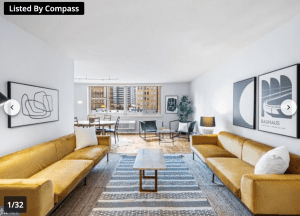Putting your home up for sale can be an exciting and nerve-wracking experience, especially in this uncertain real estate market.
To get an offer that’s near what you think your home is worth might require that you put some money and effort into sprucing up the property. It may seem perfect to your eyes, but potential buyers may see something different.
One way to overcome that is to “stage” your home – that is, prepare it to appeal to the broadest range of buyers. That used to be something only for the rich and famous, but now it’s a way any of us can make our property more presentable and appealing.
It can involve a handful of DIY projects that cost a few hundred dollars, or you can hire professional stagers at a cost of several thousand dollars.
Advocates say a well-staged home will sell for more, giving you a solid return on your investment. Many real estate agents also claim that a well-staged home will sell more quickly.
The Goal of Staging Your Home for Sale
The idea is to enable potential buyers to visualize themselves in the home. They need to be able to see it as their home, not your home.
Clay Shaffer, a Philadelphia-based realtor with Compass Real Estate, says when he sees a home, “I think ‘how is this going to appear to the general public?’ The fact is, the space is not going to appeal to a lot of people.”
A well-staged home should appear well-maintained and move-in ready, which could make buyers more willing to offer a premium price.
Professional stagers understand how to showcase a home’s layout and space, creating focal points that guide buyers through the property, emphasizing its strengths and covering up the flaws. It also allows buyers to look at unusual spaces, odd-shaped rooms, and the like, in a way that makes sense to them.
Good staging is a form of visual marketing to flatter your home, inside and out. Shaffer says that good staging can lead to beautiful photos, “and that helps me get people to want to see it.” He says 99 percent of buyers see a property online before they make an in-person visit.
First Impressions Count: Boost Your Home’s Curb Appeal
When it comes to selling a home, first impressions are everything.
You want your home to make a lasting impression the moment buyers pull up. This “curb appeal” can include doing some modest landscaping, a fresh coat of exterior paint, a new mailbox, and an inviting, clean doormat.
You can also paint the front door with a bright color, re-seal the driveway, and clean the roof tiles and gutters.
Enhancing curb appeal can entice buyers to explore the rest of the house.
Interior Home Staging Tips That Sell
Probably the two most important aspects of staging your home are reducing the clutter and depersonalizing the space. Also, use neutral colors – white, beige, and light grey.
Once again, you are used to the look and feel of your space – and hopefully like it. But the two sofas, a couple of chairs, a bean bag recliner, and more in your living room may give off a sense of too much furniture and inhibit others from seeing the potential for the room.
Clutter also makes a room look smaller, and you want to make the space look as large as possible.
A buyer should be able to move around the room without feeling as though they are maneuvering through an obstacle course.

Before Staging a Home

After Staging a Home
According to a 2023 report from the National Association of Realtors, the living room is the most commonly staged room (91%), followed by the kitchen (81%), primary bedroom (81%), and dining room (69%).
For the living room and the bedroom, it might be as simple as rearranging and paring down the furniture, or maybe replacing worn carpet.
Kitchens and bathrooms are very important to buyers, but they can be much more costly to upgrade. Some cost-effective options include removing small appliances from the counters, paring down the pantry items, painting the cabinets, and changing the hardware. Most important of all: make it shine.
After you declutter, the next step is to depersonalize. It’s important for potential buyers to envision themselves and their possessions in your home. Experts say it’s much harder to do that when your family photos are all around and your collection of fountain pens is prominently displayed. Pack them away and replace them with generic artwork.
Staging a Vacant Home: Furniture, Accessories, and Virtual Options
Vacant homes, with little or no furniture, can feel cold and uninviting, making them prime targets for staging.
Virtual staging is one option. It’s relatively inexpensive to virtually place new furniture and art. The downside is that buyers may be disappointed when they arrive and find an empty space, which can appear smaller without furniture.
Using a professional stager to rent furniture and accessories is certainly more costly, but it can help buyers envision how they can use the space, while an empty room can confuse some buyers.
If you walk into an empty bedroom, it may seem tiny, but if a buyer sees a queen-sized bed and a pair of end tables, they can envision how their furniture will work in that space.
Is Professional Home Staging Worth the Investment?
According to the online firm Thumbtack, the cost of staging a home generally ranges from $1,000 to $2,600. It says the average is $1,630.
Vacant homes generally cost more to stage because the professional stager must provide furnishings and décor, generally priced at more than $2,200.
Many homeowners may balk at laying out that much. Shaffer, the realtor, says his firm will lend the money to its clients, and their repayment is taken out of the proceeds from the sale.
Of course, there are some downsides too. Cost is the main impediment for many people, but your time and effort are also obstacles for some. Another factor for some home sellers is that they have to alter their lifestyle a bit to maintain the clean, uncluttered look that they have worked to create.
How Home Staging Fits Into Your Bigger Financial Plan
Selling your home isn’t just a lifestyle decision — it’s also one of the largest financial transactions you’ll ever make. Deciding whether to invest in staging is similar to other investment choices: you weigh the potential costs against the possible return.
For some sellers, professional staging can help secure a higher sale price or a quicker sale, which can directly impact your next financial steps — from purchasing your next home to paying down debt, boosting savings, or investing for retirement.
As financial planners, we encourage clients to treat their home sale like any other significant asset decision: evaluate the timing, the potential upside, and how it fits into their bigger financial picture. A little strategy now can help you get the most from your home sale and put you in a stronger position for what comes next.
The Bottom Line: Is Home Staging Right for You?
The bottom line is that homeowners can turn their property into a showcase that resonates emotionally with prospective buyers. That won’t guarantee a bidding war, but staging can be a smart investment that helps a home sell faster and for a higher price.
When approached thoughtfully, the extra money, or even just a quicker sale, can strengthen your overall financial position and help you move confidently into your next chapter, whether that’s buying your next home, investing for the future, or reaching other important goals.



